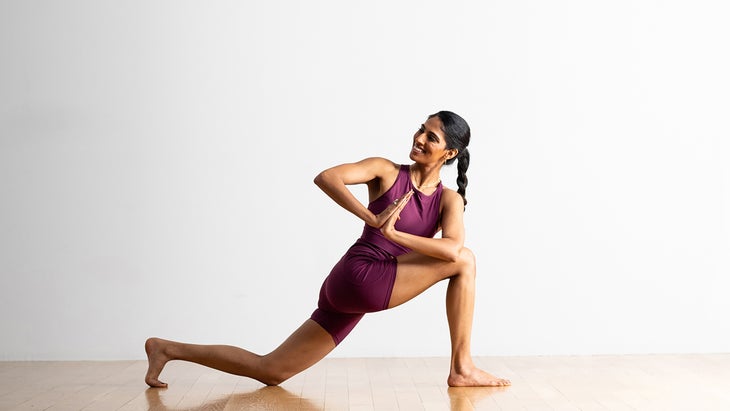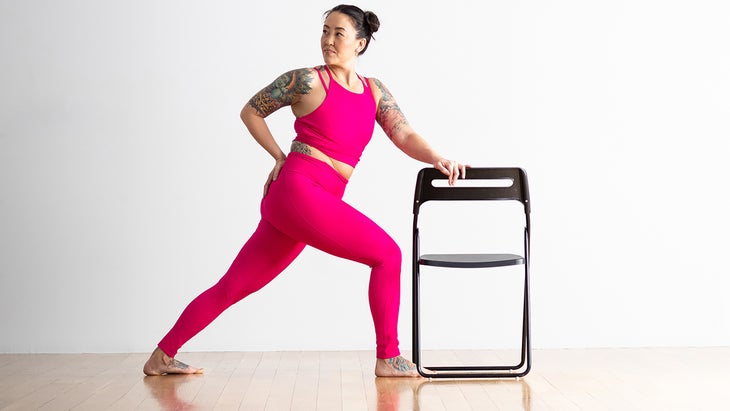Heading out the door? Read this article on the new Outside+ app available now on iOS devices for members! Download the app.
The universe moves in many ways: straight lines, curves, circles, ellipses, and apparently chaotic patterns. But a pattern you probably encounter frequently and ubiquitously in yoga is the spiral. The word spiral comes from the Latin spira, meaning to coil, and coils are everywhere, says Washington, D.C. yoga teacher John Schumacher. In yoga, twists—including Parivrtta Parsvakonasana (Revolved Side Angle Pose)—embody the essence of the spiral, Schumacher says.
Revolved Side Angle Pose is an intense twist. It challenges your flexibility, strength, sense of balance, and presence of mind. This pose is a powerful posture—but it’s not a cure all. “Twists have benefits ranging from increased flexibility to stimulated appetite,” according to Eric Grasser, MD, functional-medicine and Ayurvedic doctor in Santa Fe, New Mexico. You’ll often hear that yoga twists wring out toxins or detoxify the liver and other internal organs, but Grasser says, “There’s no scientific research that proves twisting asanas improve liver and lymphatic-system function.” However, breathing in your asana practice may help that process, he says.
This pose is part of the primary series of Ashtanga yoga but it’s found in many other classes.
Revolved Side Angle basics
Sanskrit: Parivrtta Parsvakonasana (par-ee-VRT-tah parsh-vah-cone-AHS-anna)
Pose type: Twist
Targets: Upper body
Why we love it: “When I was first cued into Revolved Side Angle Pose in a class, I thought, ‘You’ve got to be kidding me.’ With tight hips and IT band issues, I couldn’t comprehend how my anatomy could stretch to extend in all those different ways in the same moment. That was years ago, and the posture’s intense lengthening and twisting still demand more of me than I sometimes think I can give. Yet that challenge teaches me about my tendency to hold my breath, which creates tension, and that, in turn, isn’t exactly helpful. A teacher once taught me to not only bring awareness to the breath but to think less about how I think the pose should look and more on how the pose should feel. In Revolved Side Angle, I simply look to create space, in the breath and in the body by extending and expanding in opposing directions—heel to head, hand to hand.” —Yoga Journal senior editor Renee Marie Schettler.
Pose benefits
Because it massages and stimulates your abdominal organs, Revolved Side Angle can improve digestion and relieve constipation. It can also help ease low backache and sciatica. This pose also strengthens and stretches the legs, knees, ankles, groin, spine, chest, and shoulders.
Revolved Side Angle Pose: Step-by-step instructions
-
- From Downward-Facing Dog, step your left foot forward to a lunge. Square your hips toward the front of your mat.
- Keep your left knee at a 90-degree angle. Align the center of your kneecap with the center of your right ankle. If possible, bring the right thigh parallel to the floor.
- Lift the torso and raise the arms overhead into Warrior I. To create space in your torso, reach your arms up as if to touch the sky, and create length between your hip points and your armpits. Pause here, taking several long breaths.
- Lower your arms, place your palms together in Anjali mudra, and bring them so that your thumbs touch your breastbone.
- Twist your torso to the left and bring your right elbow to the outside of your left knee.
- Take your right hand to the floor or a block as you press your right arm into the outside of your knee. Reach your left arm straight up or reaching out over your left ear, with your palm facing the floor. Work toward placing the back heel on the floor. (It may not get there at first.)
- Breathe deeply, lengthening your spine as you inhale and twisting a little more as you exhale. Lengthen and soften your belly, extend your spine with each inhalation, and increase the twist as you exhale.
- Stay for 5 to 10 breaths. Place your back heel down if it isn’t already and lift out of the pose with your left arm before repeating on the other side.
- Inhale to come up, exhale to release the twist. Reverse your feet and repeat for the same length of time on your opposite side.
Teaching Revolved Side Angle
These tips will help protect your students from injury and help them have the best experience of the pose:
- Watch your back foot. If you are able to keep your back heel on the floor, rotate your back foot in more than you would for most other standing poses, about 45 to 60 degrees.
- Add props. Beginners often have difficulty maintaining their balance in this pose, especially with the back heel lifted off the floor. To improve your balance, support your heel, either by standing it on a sandbag or thick book, or by bracing it against a wall.
- Be mindful of your neck. If you have neck problems, don’t turn your head to look at the top arm; instead look straight ahead with the sides of the neck lengthened evenly, or look down at the floor. You may want to avoid Revolved Side Angle if you have a headache, high or low blood pressure, or insomnia.
Variation: Revolved Side Angle with a block

Revolved Side Angle requires a certain amount of balance. It can be helpful to use a block for support. Place a block on the inside of your bent, right knee and, as you twist, place your left hand on the block. Your right hand can rest on your heart or on your hip.
Variation: Bent Knee Revolved Side Angle Pose

Try this pose with your back knee resting on a mat or on a folded blanket for additional support if needed. Make sure that your front knee stays stacked over the front angle, and keep your hip points level and pointed forward.
Variation: Revolved Side Angle

This pose can be practiced with a chair to help you maintain balance and to leverage the twist. As you twist to the right, place your left hand on the back of the chair or lean forward and support yourself on the seat of the chair. Here, the right hand rests on the sacrum to remind you to keep the hips parallel and facing forward.
Preparatory poses
Utthita Parsvakonasana (Extended Side Angle Pose)
Ardha Matsyendrasana (Half Lord of the Fishes Pose)
Bharadvajasana I (Bharadvaja’s Twist)
Counter poses
Uttanasana (Standing Forward Bend)
Adho Mukha Svanasana (Downward-Facing Dog Pose)